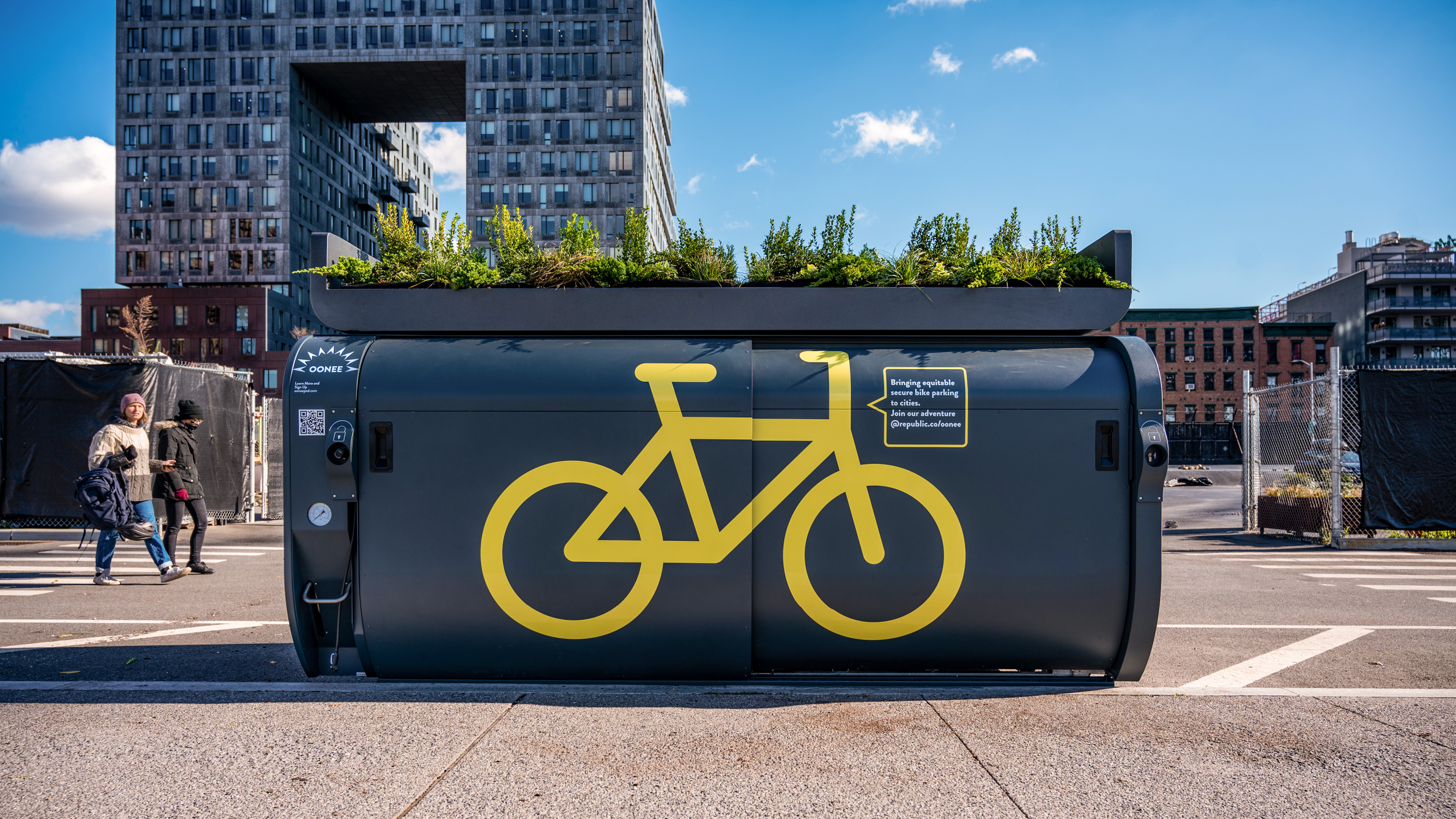How bike parking pods could make US cities better for cyclists
Cities won’t encourage more cycling if there’s nowhere to park your bike. This startup wants to change that.

In 2015, Brooklyn resident Shabazz Stuart regularly biked to his job at a local business improvement district. Then his bicycle was stolen—the third case of two-wheeled larceny he’d experienced in five years. The theft sent him back to mass transit while he saved up money to buy a replacement. It also put him on a new career path.
Paying hundreds or thousands of dollars to replace a bike can be a painful inconvenience for more privileged New Yorkers, but for working-class riders—especially delivery workers—it can be economically devastating. Thinking about the larger implications of his experience gave Stuart a business idea. In 2017 he created a company called Oonee with the goal of building out a missing piece of bicycle infrastructure in the US: secure parking.
Stuart and cofounder J. Manuel Mansyll developed a kit that can make modular parking “pods” to store anywhere from eight to 80 bicycles or scooters in a spot that’s protected from rain and theft.
Each pod is operated with a smart access system that can be controlled with a keycard or a smartphone. The units are outfitted with security cameras, and insurance against theft is provided for users. Membership is free.
New York City began investing in bike lanes under the mayorship of Michael Bloomberg in the early 2000s, hoping to increase the proportion of people traveling by bike, but the question of where to put all those vehicles was never adequately addressed. As he built Oonee, Stuart looked at New York’s practices with a newly skeptical eye. In other wealthy nations, he learned in his own research, many governments invest in cycling infrastructure much more comprehensively than even the most progressive US cities. If local policymakers weren’t addressing cyclists’ vulnerability to theft and the elements, how serious were they about encouraging bike transport?
“You cannot have a conversation about land use, outdoor dining, open streets, pedestrian plazas, bus lanes, without talking about car parking,” says Stuart. “It’s incredible to think we can have a serious conversation about biking as transportation without talking about bike parking.”
But the company’s mission is also about redressing the inequities of the cycling world, Stuart says. Bikes are often perceived as an amenity for gentrifiers, especially white upper-class professionals. But those with the lowest levels of income are the most likely to rely on bikes for commuting, and they are also much more likely to experience economic hardship if their ride is stolen.
“This misunderstanding of who relies on cycling for transportation reverberates to where we are today with a lack of cogent and compelling infrastructure to support cycling,” says Stuart, who is Black. He says he has intentionally tried to staff Oonee in a fashion that reflects the demographics of the city and its bike riders.
Oonee is still in its early days, with about 4,000 users across a handful of pods in New York and Jersey City, just across the Hudson River. The contingent of dedicated users is smaller; Stuart says about 10% of the members represent 90% of the usage. But the stage is set for growth: the company already has plans to improve its geographic coverage, with nine more full-size pods as well as dozens of smaller ones called “Minis,” which hold up to 10 bikes.
There is a wider opportunity right now to make protected bike parking a norm in US cities, Stuart says. “The average person is socialized to bike-share, but 15 years ago that wasn’t the case,” he says. “We’re going to raise the bar. Cyclists are going to say, ‘Why isn’t this in my city?’”
Keep Reading
Most Popular
Large language models can do jaw-dropping things. But nobody knows exactly why.
And that's a problem. Figuring it out is one of the biggest scientific puzzles of our time and a crucial step towards controlling more powerful future models.
The problem with plug-in hybrids? Their drivers.
Plug-in hybrids are often sold as a transition to EVs, but new data from Europe shows we’re still underestimating the emissions they produce.
How scientists traced a mysterious covid case back to six toilets
When wastewater surveillance turns into a hunt for a single infected individual, the ethics get tricky.
Google DeepMind’s new generative model makes Super Mario–like games from scratch
Genie learns how to control games by watching hours and hours of video. It could help train next-gen robots too.
Stay connected
Get the latest updates from
MIT Technology Review
Discover special offers, top stories, upcoming events, and more.